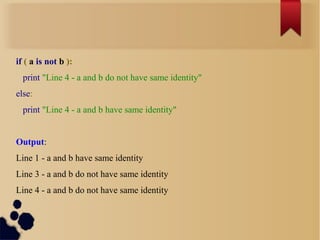Python slide.1
- 2. Python Programming Python is a high-level, interpreted, interactive and object-oriented scripting language. ● ● ● Python is Interpreted: This means that it is processed at runtime by the interpreter and you do not need to compile your program before executing it. Python is Interactive: This means that you can actually sit at a Python prompt and interact with the interpreter directly to write your programs Python is Object-Oriented: This means that Python supports Object-Oriented style
- 3. History of Python Python was developed by Guido van Rossum in the late eighties and early nineties at the National Research Institute for Mathematics and Computer Science in the Netherlands. C++...etc Python is derived from many other languages, including C,
- 4. Python Features ➢ Easy-to-learn: Python has relatively few keywords, simple structure, and a clearly defined syntax. This allows the student to pick up the language in a relatively short period of time. ➢ Easy-to-read: Python code is much more clearly defined and visible to the eyes. ➢ Easy-to-maintain: Python's success is that its source code is fairly easy-to-maintain. ➢ Portable: Python can run on a wide variety of hardware platforms and has the same interface on all platforms. ➢ Extendable: You can add low-level modules to the Python interpreter.
- 5. Python Basic Syntax The Python language has many similarities to C and Java. However, there are some definite differences between the languages like in syntax also. Python Identifiers: A Python identifier is a name used to identify a variable, function, class, module or other object. An identifier starts with a letter A to Z or a to z or an underscore (_) followed by zero or more letters, underscores and digits (0 to 9). Python does not allow punctuation characters such as @, $ and % within identifiers. Python is a case sensitive programming language. Thus, Manpower and manpower are two different identifiers in Python.
- 6. Reserved Words: The following list shows the reserved words in Python. These reserved words may not be used as constant or variable or any other identifier names. All the Python keywords contain lowercase letters only.
- 8. Lines and Indentation: In python there are no braces to indicate blocks of code for class and function definitions or flow control. Blocks of code are denoted by line indentation. The number of spaces in the indentation is variable, but all statements within the block must be indented the same amount. Both blocks in this example are fine:
- 9. Example: if True: print "True" else: print "False" However, the second block in this example will generate an error: if True: print "Answer" print "True" else: print "Answer" print "False" <----Error Thus, in Python all the continous lines indented with similar number of spaces would form a block.
- 10. Multi-Line Statements: Statements in Python typically end with a new line. Python does, however, allow the use of the line continuation character () to denote that the line should continue. Example: total = item_one + item_two + item_three <----New line charactor Statements contained within the [], {} or () brackets do not need to use the line continuation character. Example: days = ['Monday', 'Tuesday', 'Wednesday', 'Thursday', 'Friday']
- 11. Quotation in Python: Python accepts single ('), double (") and triple (''' or """) quotes to denote string literals, as long as the same type of quote starts and ends the string.The triple quotes can be used to span the string across multiple lines Example: word = 'word' <--------------- single sentence = "This is a sentence." <------------- double paragraph = """This is a paragraph. It is made up of multiple lines and sentences.""" <------------ triple
- 12. Python Variable Types Variables are nothing but reserved memory locations to store values. This means that when you create a variable you reserve some space in memory. Based on the data type of a variable, the interpreter allocates memory and decides what can be stored in the reserved memory. Therefore, by assigning different data types to variables, you can store integers, decimals or characters in these variables. Assigning Values to Variables: Python variables do not have to be explicitly declared to reserve memory space. The declaration happens automatically when you assign a value to a variable. The equal sign (=) is used to assign values to variables. The operand to the left of the = operator is the name of the variable and the operand to the right of the = operator is the value stored in the variable.
- 13. Example: counter = 100 miles = 1000.0 name = "John" # An integer assignment # A floating point # A string print counter print miles print name Here, 100, 1000.0 and "John" are the values assigned to counter, miles and name variables, respectively. While running this program, this will produce the following result: Output: 100 1000.0 John
- 14. Multiple Assignment: Python allows you to assign a single value to several variables simultaneously. Example: a=b=c=1 Here, an integer object is created with the value 1, and all three variables are assigned to the same memory location. You can also assign multiple objects to multiple variables. For example: a, b, c = 1, 2, "john" Here, two integer objects with values 1 and 2 are assigned to variables a and b, and one string object with the value "john" is assigned to the variable c.
- 15. Python Numbers: Number data types store numeric values. They are immutable data types which means that changing the value of a number data type results in a newly allocated object. Number objects are created when you assign a value to them. For example: var1 = 1 var2 = 10 You can delete a single object or multiple objects by using the del statement. For example: del var del var_a, var_b
- 16. Python supports four different numerical types: int long float complex int : 10 , -786 long : 51924361L , -0x19323L float : 0.0 , -21.9 complex : 3.14j
- 17. Python Strings: Strings in Python are identified as a contiguous set of characters in between quotation marks. Python allows for either pairs of single or double quotes. Subsets of strings can be taken using the slice operator ( [ ] and [ : ] ) with indexes starting at 0 in the beginning of the string and working their way from -1 at the end. The plus ( + ) sign is the string concatenation operator and the asterisk ( * ) is the repetition operator. Example: str = 'Hello World!' print str print str[0] # Prints complete string # Prints first character of the string
- 18. print str[2:5] # Prints characters starting from 3rd to 5th print str[2:] # Prints string starting from 3rd character print str * 2 # Prints string two times print str + "TEST" # Prints concatenated string Output: Hello World! H llo llo World! Hello World!Hello World! Hello World!TEST
- 19. Python Lists: Lists are the most versatile of Python's compound data types. A list contains items separated by commas and enclosed within square brackets ([]). Example: list = [ 'abcd', 786 , 2.23, 'john', 70.2 ] tinylist = [123, 'john'] print list # Prints complete list print list[0] # Prints first element of the list print list[1:3] # Prints elements starting from 2nd till 3rd print list[2:] # Prints elements starting from 3rd element print tinylist * 2 # Prints list two times print list + tinylist # Prints concatenated lists
- 20. Python Tuples: A tuple is another sequence data type that is similar to the list. A tuple consists of a number of values separated by commas. Unlike lists, however, tuples are enclosed within parentheses. The main differences between lists and tuples are: Lists are enclosed in brackets ( [ ] ) and their elements and size can be changed, while tuples are enclosed in parentheses ( ( ) ) and cannot be updated. Example: tuple = ( 'abcd', 786 , 2.23, 'john', 70.2 ) tinytuple = (123, 'john')
- 21. print tuple # Prints complete list print tuple[0] # Prints first element of the list print tuple[1:3] # Prints elements starting from 2nd till 3rd print tuple[2:] # Prints elements starting from 3rd element print tinytuple * 2 # Prints list two times print tuple + tinytuple # Prints concatenated lists Output: ('abcd', 786, 2.23, 'john', 70.200000000000003) abcd (786, 2.23)
- 22. (2.23, 'john', 70.200000000000003) (123, 'john', 123, 'john') ('abcd', 786, 2.23, 'john', 70.200000000000003, 123, 'john') Following is invalid with tuple, because we attempted to update a tuple, which is not allowed. Similar case is possible with lists: tuple = ( 'abcd', 786 , 2.23, 'john', 70.2 ) list = [ 'abcd', 786 , 2.23, 'john', 70.2 ] tuple[2] = 1000 # Invalid syntax with tuple list[2] = 1000 # Valid syntax with list
- 23. Python Dictionary: Python's dictionaries are kind of hash table type. They work like associative arrays or hashes found in Perl and consist of key-value pairs. A dictionary key are usually numbers or strings. Dictionaries are enclosed by curly braces ( { } ) and values can be assigned and accessed using square braces ( [] ). For example: dict = {} dict['one'] = "This is one" dict[2] = "This is two" tinydict = {'name': 'john','code':6734, 'dept': 'sales'}
- 24. print dict['one'] # Prints value for 'one' key print dict[2] # Prints value for 2 key print tinydict # Prints complete dictionary print tinydict.keys() # Prints all the keys print tinydict.values() # Prints all the values Output: This is one This is two {'dept': 'sales', 'code': 6734, 'name': 'john'} ['dept', 'code', 'name'] ['sales', 6734, 'john']
- 25. Operators Simple answer can be given using expression 4 + 5 is equal to 9. Here, 4 and 5 are called operands and + is called operator. Python language supports the following types of operators. ➢ Arithmetic Operators ➢ Comparison (i.e., Relational) Operators ➢ Assignment Operators ➢ Logical Operators ➢ Bitwise Operators ➢ Membership Operators ➢ Identity Operators
- 26. Python Arithmetic Operator a = 21 b = 10 C=0 c=a+b print "Line 1 - Value of c is ", c c=a-b print "Line 2 - Value of c is ", c c=a*b print "Line 3 - Value of c is ", c
- 27. c=a/b print "Line 4 - Value of c is ", c c=a%b print "Line 5 - Value of c is ", c a=2 b=3 c = a**b print "Line 6 - Value of c is ", c a = 10 b=5 c = a//b print "Line 7 - Value of c is ", c
- 28. Output: Line 1 - Value of c is 31 Line 2 - Value of c is 11 Line 3 - Value of c is 210 Line 4 - Value of c is 2 Line 5 - Value of c is 1 Line 6 - Value of c is 8 Line 7 - Value of c is 2
- 31. Bitwise Operator
- 32. Logical Operator
- 34. Example: a = 10 b = 20 list = [1, 2, 3, 4, 5 ]; if ( a in list ): print "Line 1 - a is available in the given list" else: print "Line 1 - a is not available in the given list" if ( b not in list ): print "Line 2 - b is not available in the given list" else: print "Line 2 - b is available in the given list"
- 35. a=2 if ( a in list ): print "Line 3 - a is available in the given list" else: print "Line 3 - a is not available in the given list" Output: Line 1 - a is not available in the given list Line 2 - b is not available in the given list Line 3 - a is available in the given list
- 37. a = 20 b = 20 if ( a is b ): print "Line 1 - a and b have same identity" else: print "Line 1 - a and b do not have same identity"
- 38. b = 30 if ( a is b ): print "Line 3 - a and b have same identity" else: print "Line 3 - a and b do not have same identity"
- 39. if ( a is not b ): print "Line 4 - a and b do not have same identity" else: print "Line 4 - a and b have same identity" Output: Line 1 - a and b have same identity Line 3 - a and b do not have same identity Line 4 - a and b do not have same identity

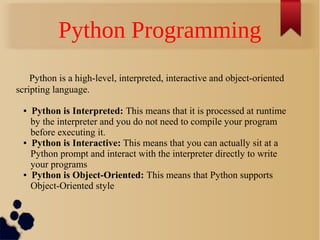

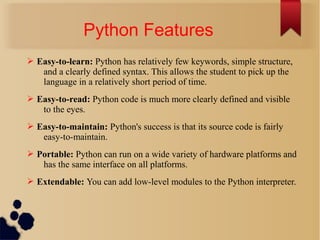

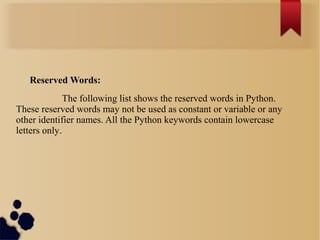
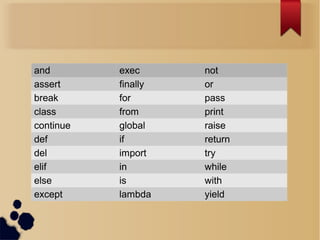

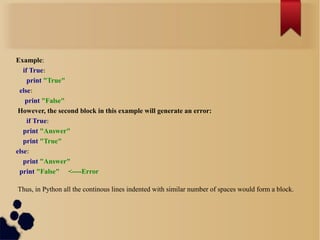
![Multi-Line Statements:
Statements in Python typically end with a new line. Python does, however, allow the use of the
line continuation character () to denote that the line should continue.
Example:
total = item_one +
item_two +
item_three
<----New line charactor
Statements contained within the [], {} or () brackets do not need to use the line continuation character.
Example:
days = ['Monday', 'Tuesday', 'Wednesday',
'Thursday', 'Friday']](https://image.slidesharecdn.com/pythonslide-140215063902-phpapp01/85/Python-slide-1-10-320.jpg)
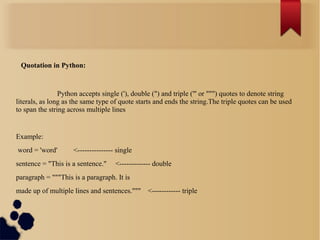
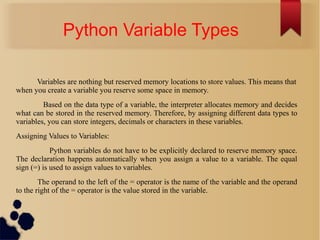




![Python Strings:
Strings in Python are identified as a contiguous set of characters in between quotation
marks. Python allows for either pairs of single or double quotes. Subsets of strings can be
taken using the slice operator ( [ ] and [ : ] ) with indexes starting at 0 in the beginning of
the string and working their way from -1 at the end.
The plus ( + ) sign is the string concatenation operator and the asterisk ( * ) is the
repetition operator.
Example:
str = 'Hello World!'
print str
print str[0]
# Prints complete string
# Prints first character of the string](https://image.slidesharecdn.com/pythonslide-140215063902-phpapp01/85/Python-slide-1-17-320.jpg)
![print str[2:5]
# Prints characters starting from 3rd to 5th
print str[2:]
# Prints string starting from 3rd character
print str * 2
# Prints string two times
print str + "TEST" # Prints concatenated string
Output:
Hello World!
H
llo
llo World!
Hello World!Hello World!
Hello World!TEST](https://image.slidesharecdn.com/pythonslide-140215063902-phpapp01/85/Python-slide-1-18-320.jpg)
![Python Lists:
Lists are the most versatile of Python's compound data types. A list contains items separated by
commas and enclosed within square brackets ([]).
Example:
list = [ 'abcd', 786 , 2.23, 'john', 70.2 ]
tinylist = [123, 'john']
print list
# Prints complete list
print list[0]
# Prints first element of the list
print list[1:3]
# Prints elements starting from 2nd till 3rd
print list[2:]
# Prints elements starting from 3rd element
print tinylist * 2 # Prints list two times
print list + tinylist # Prints concatenated lists](https://image.slidesharecdn.com/pythonslide-140215063902-phpapp01/85/Python-slide-1-19-320.jpg)
![Python Tuples:
A tuple is another sequence data type that is similar to the list. A
tuple consists of a number of values separated by commas. Unlike lists,
however, tuples are enclosed within parentheses.
The main differences between lists and tuples are: Lists are
enclosed in brackets ( [ ] ) and their elements and size can be changed,
while tuples are enclosed in parentheses ( ( ) ) and cannot be updated.
Example:
tuple = ( 'abcd', 786 , 2.23, 'john', 70.2 )
tinytuple = (123, 'john')](https://image.slidesharecdn.com/pythonslide-140215063902-phpapp01/85/Python-slide-1-20-320.jpg)
![print tuple
# Prints complete list
print tuple[0]
# Prints first element of the list
print tuple[1:3]
# Prints elements starting from 2nd till 3rd
print tuple[2:]
# Prints elements starting from 3rd element
print tinytuple * 2 # Prints list two times
print tuple + tinytuple # Prints concatenated lists
Output:
('abcd', 786, 2.23, 'john', 70.200000000000003)
abcd
(786, 2.23)](https://image.slidesharecdn.com/pythonslide-140215063902-phpapp01/85/Python-slide-1-21-320.jpg)
![(2.23, 'john', 70.200000000000003)
(123, 'john', 123, 'john')
('abcd', 786, 2.23, 'john', 70.200000000000003, 123, 'john')
Following is invalid with tuple, because we attempted to update a tuple, which is
not allowed. Similar case is possible with lists:
tuple = ( 'abcd', 786 , 2.23, 'john', 70.2 )
list = [ 'abcd', 786 , 2.23, 'john', 70.2 ]
tuple[2] = 1000 # Invalid syntax with tuple
list[2] = 1000
# Valid syntax with list](https://image.slidesharecdn.com/pythonslide-140215063902-phpapp01/85/Python-slide-1-22-320.jpg)
![Python Dictionary:
Python's dictionaries are kind of hash table type. They work like associative arrays
or hashes found in Perl and consist of key-value pairs. A dictionary key are usually
numbers or strings.
Dictionaries are enclosed by curly braces ( { } ) and values can be assigned and
accessed using square braces ( [] ). For example:
dict = {}
dict['one'] = "This is one"
dict[2]
= "This is two"
tinydict = {'name': 'john','code':6734, 'dept': 'sales'}](https://image.slidesharecdn.com/pythonslide-140215063902-phpapp01/85/Python-slide-1-23-320.jpg)
![print dict['one']
# Prints value for 'one' key
print dict[2]
# Prints value for 2 key
print tinydict
# Prints complete dictionary
print tinydict.keys() # Prints all the keys
print tinydict.values() # Prints all the values
Output:
This is one
This is two
{'dept': 'sales', 'code': 6734, 'name': 'john'}
['dept', 'code', 'name']
['sales', 6734, 'john']](https://image.slidesharecdn.com/pythonslide-140215063902-phpapp01/85/Python-slide-1-24-320.jpg)

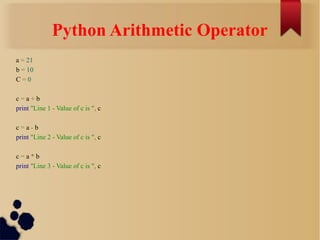







![Example:
a = 10
b = 20
list = [1, 2, 3, 4, 5 ];
if ( a in list ):
print "Line 1 - a is available in the given list"
else:
print "Line 1 - a is not available in the given list"
if ( b not in list ):
print "Line 2 - b is not available in the given list"
else:
print "Line 2 - b is available in the given list"](https://image.slidesharecdn.com/pythonslide-140215063902-phpapp01/85/Python-slide-1-34-320.jpg)




